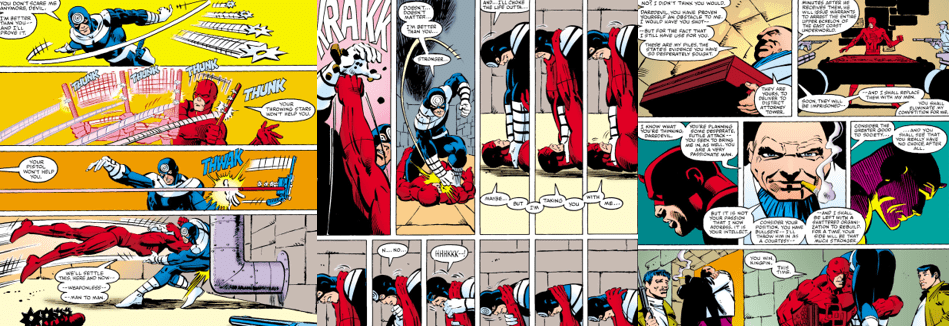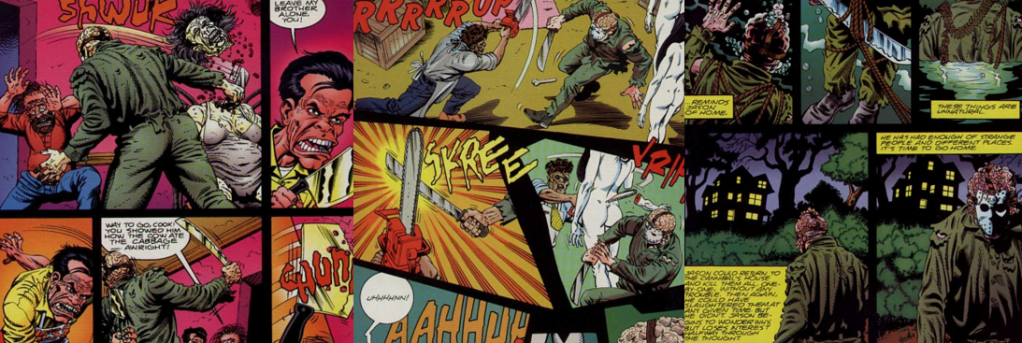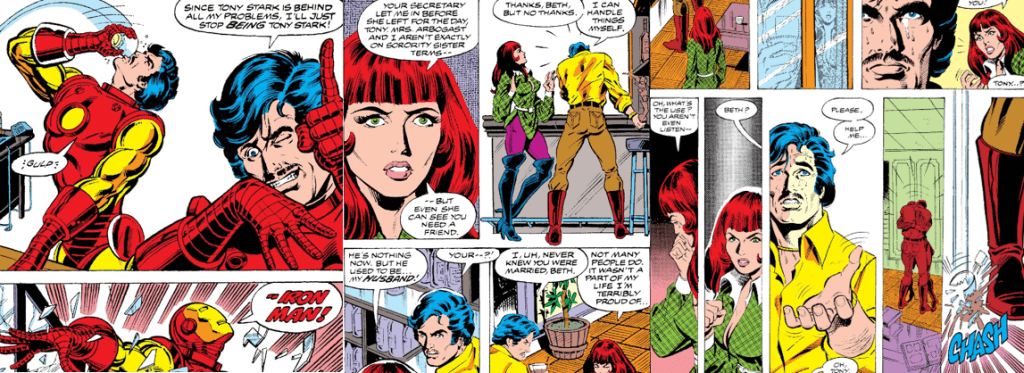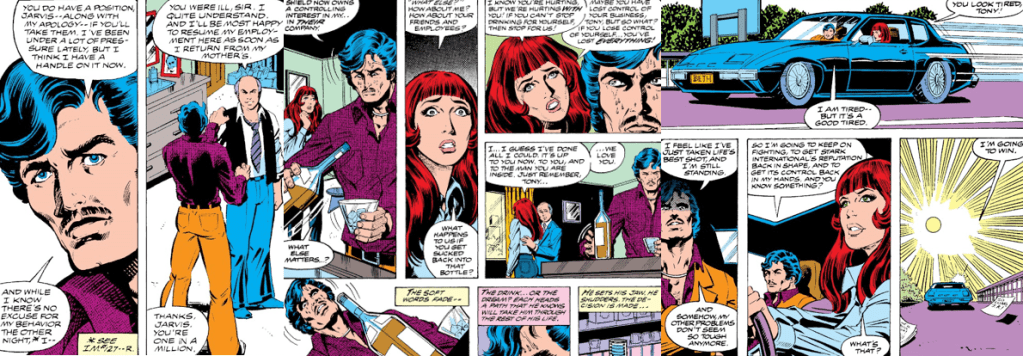In April of 1985, the first issue of the ground-breaking, twelve issue Crisis on Infinite Earths (Wolfman, et al, 1986) was published. This event, which was easily the biggest in DC Comics at that point (and for many years), saw the destruction of the “Multiverse”, an infinite number of parallel worlds, and the awkward establishing of one unified DC canon. Over the years, DC have returned to this concept again and again, retconning it, expanding upon it, and milking it to the point of excess but that doesn’t change how influential this massive crossover was. To celebrate this momentous event, I’ve been looking at multiversal crossovers every Thursday in April in an event I call “Crossover Crisis”.
Published: August 2009 to December 2009
Writers: Jeff Katz and James Kuhoric
Artist: Jason Craig
The Background:
Although it is regarded as one of the best slasher properties around, Paramount Pictures became embarrassed with their Friday the 13th franchise (1980 to present) and sold (some of) the rights to rival studio New Line Cinema back in the early-2000s. This led to the long-awaited clash between Friday’s iconic killer, Jason Voorhees (Various) and New Line’s Freddy Krueger (Robert Englund) after years in Development Hell. Despite mixed reviews, Freddy vs. Jason’s (Yu, 2003) box office gross of nearly $117 million made it he most profitable entry in either franchise and naturally led to talks of a sequel. Unfortunately, these fell apart due to rights issues surrounding fellow horror icon Ashley “Ash” Williams (Bruce Campbell), but the three horror heavyweights did meet up in Freddy vs. Jason vs Ash (Kuhoric, et al, 2007 to 2008) courtesy of WildStorm and Dynamite Entertainment. Based on Jeff Katz’s film treatment, Freddy vs. Jason vs. Ash proved successful enough to warrant a follow-up the following year that was originally envisioned as a twelve-issue story before being scaled back. Katz returned to co-write the story, which he envisioned as a massive conclusion to the Freddy vs. Jason trilogy and a love letter to all three franchises. Fellow writer James Kuhoric was adamant about ensuring all the returning characters felt familiar to series fans, with special emphasis put on the clash of personalities between Ash and Tommy Jarvis. The two also sought to redesign Jason, giving him a Grim Reaper-like visage, and make the most of the unrestricted nature of the new format to show more over-the-top kills on a much larger scale. Although some saw The Nightmare Warriors as an improvement on the first crossover due to its larger scale, it was also criticised for being somewhat mindless and predictable and for struggling to juggle not just the titular horror icons but its extended cast of characters.
The Review:
The Nightmare Warriors opens twenty-four hours after the end of Freddy vs. Jason vs. Ash, with undead killer Jason Voorhees still trapped under the bumper of Ash Williams’ beloved Oldsmobile, still with a machete blade where his left hand once was, and still missing his trademark hockey mask, beneath the frigid depths of Crystal Lake. Cursed with eternal unlife by the Necronomicon Ex Mortis, Jason is compelled to return to the world of the living at the urging of his mother, Pamela, though it’s once again dream demon Freddy Kruger assuming Pamela’s form to reactivate Jason and set him against Ash for besting them in the previous crossover. At that same moment, a group of government agents, led by Director Gordon Russell, arrive to secure the area, intent on securing the Necronomicon for themselves, deeming its power to open rifts and raise demons more enticing than the unkillable Jason. Within mere panels, his team find and thaw out the book and spirit it back to base, while a separate team dives into the lake to retrieve Jason and nullify him. Unfortunately for the frogmen, Jason bursts to life and slaughters them all, shrugging off their bullets and high-powered shock lancers and dicing them to bloody pieces, then retrieves the remains of his mask and heads out to find Ash at this “mother’s” bidding. Spreading of Ash, the story jumps over the Franklin, Michigan and ahead six months; Ash’s narration once again brings us up to speed on his life: after defeating Freddy and Jason, he and surviving girl Caroline (or “Carrie”) settled down into suburbia, despite the dramatic age gap between them. Their domestic bliss is interrupted by the first of many returning faces when Doctor Maggie Burroughs (also known as Katherine Kruger, Freddy’s daughter and noted child counsellor) drops by. Since the events of Freddy’s Dead: The Final Nightmare (Talalay, 1991), Maggie has been working with another prominent Elm Street character, child psychiatrist Doctor Neil Gordon, to identify special “focal magnets” for the supernatural who can combat dark forces.

Although she’s come to the right place, given Ash is the “Chosen One”, Ash has given up his Deadite-slaying ways and has no interest in joining their crusade to pre-emptively target the dark evils of the world and Maggie leaves empty handed. Ash heads out on a beer run, blissfully ignorant to the fact that Jason is tearing into his house and attacking Carrie. Although she desperately fights back, she’s no match for Jason and her head ends up cooking on the barbecue. On the drive back, Ash catches wind of this when he gets a vision of Freddy – not unlike the visions suddenly striking Stephanie Kimble, “Dream Master” Alice Johnson, and her teenage son, Jacob – between the panels, but he arrives too late to help and is pegged as a murderer by Carrie’s family. As a mysterious individual watches on, Ash fights off Carrie’s dad and makes a run for it as the cops arrive, hopping on the first train out of there to go find Maggie. Although Maggie seems to sense her father’s return, she allays the fears of her lover, Neil, since they’re protected by the dream-blocking powers of Hypnocil. She also assures their two psychic recruits, Rennie Wickham and Tina Shepherd, that they have nothing to fear and excites them with the prospect of new recruits joining their cause. Neil, however, isn’t completely sold on Maggie’s plan, especially after seeing a similar group of survivors butchered by Freddy in the past, but Maggie convinces him with her words (and her allure) that the survivors of Freddy and Jason’s rampages are special, crucial, to stopping such monsters. Their new recruits turn out to be Alice, Jacob, Stephanie and her father, Steven Freeman (referred to as “Stephen”). Just as they arrive, Stephanie suffers a massive seizure, bombarded by visions of Jason, who adds a bunch more bodies to his kill list when he follows Ash. Meanwhile, at the Pentagon, Director Russell and his team’s hard work translating the Necronomicon with some pretty futuristic technology sees them return Freddy to the real world, now fully mortal and free of his burns. Although Freddy gives Director Russell the run-around and plays coy, he gives them enough to confirm the book’s power and Russell orders a strike team to intercept Jason, who’ve they’ve tracked to Maggie’s house.
Jason makes a dramatic entrance shortly after Ash arrives looking to avenge Carrie’s death; Stephen’s incredulity about the entire thing turns to abject terror at the sight of Jason, who unceremoniously caves his head in, but the others are saved when the mysterious onlooker, Tommy Jarvis, bursts in to spirit them away in his jeep. The strike team arrives soon after and subdues Jason with sleeping gas, bringing him into custody at last. Chastising their efforts and clashing egos with Ash, Tommy warns about Jason’s brutality and power and begs them to leave it to him given his past experience, but Maggie won’t hear of it. She touts Rennie’s empathic power and each of the group reveals some of their past experiences with both killers and their special abilities, such as Alice sporting dream-based powers and Tina being somewhat telekinetic, and Ash naturally boasting off his Deadite-slaying past. Maggie desperately calls for he and Tommy to set aside their egos and focus on using the Necronomicon to put both monsters down for good, stating that her father oversees the project to research it, but the group remains divided. At the Pentagon, Jason is wheeled into a Deadite holding cell and once again falls prey to Freddy’s influence. Somehow possessing the Necronomicon’s power along with his dream powers, Freddy brags of his plot to use Russell to finish what he started in Freddy vs. Jason vs. Ash. Although Jason still wants to kill Freddy, he’s convinced to join forces with Freddy mentions Tommy’s name and Freddy uses the magic words – “Klattu! Verata! Nikto!” – to restore, repair, and upgrade Jason’s body and mind, turning him into Freddy’s long-haired, dual-machete-wielding General. Later that evening, Ash and the others (sans Tommy, Stephanie, and Jacob) enter the Pentagon using Maggie’s credentials and are immediately locked up on Director Russell’s orders despite their warnings about Freddy. As Ash questions Maggie’s relationship with Russell, she’s brought to Freddy, who can freely shift between a normal human and his burned form and has physically merged with the Necronomicon, effectively making him a God. In a dramatic moment, Maggie murders Russell with Freddy’s glove and reveals that she’s been working with Freddy the whole time, the two apparently in a very sexual incestuous relationship.

Although Neil believes it to be some kind of brainwashing, Maggie goes the whole hog and kills him and Rennie, rechristening herself Kathryn Kruger and being transformed by Freddy into a claw-handed murderess. Thanks to Tina’s psychic powers, Ash and the others are alerted to the betrayal just as the Pentagon goes on high alert after Jason leads the Deadite army in a jail break. Although desperate for some payback, Ash is convinced to flee by Tina and Alice; when he tries to retrieve the Necronomicon, he’s attacked by a claw-wielding machine controlled by Freddy but a combination of Tina’s psychic powers and Ash’s bravado brings it down. Tommy is aghast to see Jason leading the medieval dead on a killing spree throughout the nation’s capital, though his attempts to stop the masked killer are for naught as he’s quickly captured by a couple of bat-like Deadites and brought to Freddy, leaving Jason and the Deadites free to carve up congress. Back at the Stabe Hotel, Jacob is seduced by Stephanie in a nightmarish ruse by Freddy, who binds and tortures him until he cries for his mother. Sensing his plight, Alice uses her powers to transport herself, Ash, and Tina into Jacob’s nightmare, but they’re unable to keep Freddy from kidnapping Jacob and challenging them to confront him at the White House. Thankfully, they’re able to put Stephanie back together in the dreamworld and save her life, though the experience of being skinned alive in the nightmare leaves her traumatised. At the White House, the Deadites hold off the military and the cops and allow Freddy to address the nation, first using the guise of President George W. Bush and then reverting to a less despicable visage, his own burnt form, to dictate his “No Kid Left Alive” policy and declare war on the children of America.
Ash galvanises Alice, Tina, and Stephanie and they gear up to go rescue Jacob; they find Washington swarming with Deadites and blood raining from the skies and their resolve falters when Alice chastises Ash’s plan of simply fighting their way to victory. Luckily, the military arrive and cause a big enough distraction; their wholesale attack upon the Deadites and Freddy’s focus on repelling their forces allows Ash and the others to slip past the undead defences, but the distressed Stephanie is lost when she wanders off and has her untapped Voorhees blood awakened by Freddy’s influence, turning her into a mindless killer like her…I wanna say uncle?…that sees her don her own hockey mask and set out to fulfil her birthright and kill Jason. In the Oval Office, Freddy brags of his superiority to the captive Tommy but, annoyed by the kid’s defiance, prepares to kill him when Jason intervenes, wanting the kill for himself. This is again enough to turn the two against each other; Freddy orders Kathryn to kill Jason and the two get into it, with Kathryn cutting chunks out of Jason and even impaling him on a flagpole, but the fight is interrupted when Ash comes crashing in in a tank, crushing Kathryn and blowing Freddy clear out of the Oval Office with a cannon shot. As Ash and the others rescue Tommy and Jacob, Freddy literally pulls himself together out on the lawn where he’s confronted by Alice; when Freddy mocks her chances and boasts of his immortality, she allows herself to be killed since she has a terminal disease, but her death passes her Dream Master powers to Jacob and releases the spirits of the original Dream Warriors and Freddy’s mother, Amanda. Suitably empowered, Jacob and the Dream Warriors dispatch of Freddy’s Deadite forces, bringing Freddy to his knees in defeat once more.
However, as Amanda prepares to bring Freddy’s soul to be judged by the Almighty, Freddy drops the ruse and guts Jacob; Ash and Tommy clash one last time as they try to get their priorities straight and ultimately agree to let Tommy have his wish to be the one to finish Jason off. Tommy attacks Jason with all his anger and strength but is, of course, physically outmatched by the revitalised killer; drawing strength from all the pain and death Jason has caused, Tommy pummels him with a rock but falters when he sees Jason’s unblemished face. The normally silent monster utters the words “Yew… daie!” and leaves Tommy with a shoulder injury and facing certain death. Luckily, Stephanie impales Jason with two machetes to the back, distracting him long enough for Tommy to behead him with a massive shard of glass and triumphantly hold up his severed head. As Tina desperately tries to stop Jacob from bleeding out, Freddy feasts upon both the souls of the Dream Warriors and of Jason himself; Ash thrusts the Necronomicon into Neil’s hands and demands he find a passage to end the nightmare and buys him time by battling Freddy once more but all hope seems lost as Neil can’t read the book’s language. However, the spirit of his former lover, Nancy Thompson, arrives to help and, together, they speak the cursed words, opening another vortex. Although Freddy’s power is such that he can resist the portal’s pull, the Dream Demons (revealed to be dwelling within the Necronomicon) express outrage at his failures and remove his powers, leaving him vulnerable to one last quip from Ash and a shotgun to the chest, which sends him flying into the vortex. Nancy and Neil share a tearful farewell and, as the nation recovers, a victorious Ash and Tina share a completely random kiss and he parts ways with Tommy with a mutual respect. However, Jason’s body disappears from the battlefield and the story ends in Springwood, 1964, where a random cop caught in the Necronomicon’s vortex blindly signs Freddy’s arrest warrant, apparently changing Freddy’s past despite him laughing from the clouds? It’s a bit confusing, if I’m honest.
The Summary:
Freddy vs. Jason vs. Ash: The Nightmare Warriors suffers from a lot of the issues that plagued the last crossover; the story is a bit of a mess, with twists and turns that pop up seemingly at random just to drag the story out to six issues, and with some underdeveloped themes and conflicts. Like, I must have missed when the Pentagon conjured enough Deadites to need a prison for them, and I’m not sure why Director Russell thought he could manipulate Freddy so easily, plus it’s really out of character for Maggie to suddenly be so on her father’s side that she not only kills in his name but is turned on by his affections. The art is also quite inconsistent again; it picks up from issue four but there are a lot of instances where the artist is again simply copying shots from Freddy vs. Jason and I had a hard time recognising a lot of the returning characters. Stephen looks more like a scowling Marshall Mathers III/Eminem than his film counterpart, I kept mixing Stephanie, Rennie, and Alice up and I just don’t think enough was done to visually make them stand out from each other. Alice, for example, should be far older than she’s portrayed here, which would’ve helped. I genuinely forgot Jacob was even in this until he was kidnapped, and I can’t say I cared much for Tommy’s characterisation; get him being gung-ho about wanting to end Jason, but I like to think he would see the benefits of joining forces with the so-called “Nightmare Warriors”. I did enjoy seeing him clash with Ash; I genuinely think the story might’ve been stronger with more focus on those two being an odd couple pairing and placing more emphasis on the Ash/Tina relationship since she randomly kisses him at the end despite there being no chemistry between them prior to that.

Ash is a little different here than in Freddy vs. Jason vs. Ash, at least initially. He’s settled down with Carrie and is happy to leave his past behind, but he’s brought back into the fight when she’s killed by Jason. Unlike the opening of the last crossover, I enjoyed this death since Carrie lasted a little longer and her death pushed Ash into joining up with Maggie and gave him a greater personal stake in the battle against Freddy and Jason. It’s not one that’s fully realised since Ash tangles more with Freddy, which I get as it’s fun seeing them trade insults as well as blows, but he doesn’t really fight with Jason all that much and, unlike the last crossover, there’s no three-way dance between them this time. Ash is also a little more contentious this time around; he clashes with Tommy, of course, but also aggravates Alice with his misogynistic attitude and inability to think of a plan beyond just ploughing through what’s in front of him. The Deadites get a little more play this time around, with Jason leading the medieval dead and them chattering away as they’re killing and being killed, but they primarily exist to be cannon fodder for the military, Ash, and the Nightmare Warriors. Speaking of whom, I did enjoy seeing these surviving characters return, even if they’re not as strong or visually interesting as the Dram Warriors. The only really useful one was Tina, and even she just blasted doors open and levitated stuff; Alice only became useful by dying and even then Jacob was attacked before he could finish offing the Deadites, meaning the returning characters were more like fan service than anything else.
I don’t mind this; a story titled Freddy vs Jason vs. Ash should be heavy on the fan service, after all, but it does mean this story is even more bogged down with exposition than the last one as we need a recap on what everyone’s been up to since their last appearances. As before, Jason trumps Freddy in terms of kills; he hacks, bludgeons, and slaughters too many people to count here and it’s just as gruesome and glorious as you could ask for, but he is also once again relegated to being Freddy’s minion. At least this time he gets a visual upgrade and even speaks, but he doesn’t seem any more intelligent and the plot point of Stephanie “becoming a Voorhees” amounts to a mere distraction. Although the story makes a dramatic show of Jason’s beheading, we know he isn’t really dead as “only a Voorhees” can truly kill him and, as Pamela states, he can “never die”. Freddy is basically the same as in the last story, being a master manipulator but sporting incredible (and ill-defied) dark powers thanks to the Necronomicon. Having absorbed the book into himself, he can freely manipulate the waking world as he does the dream world but does little with this except send Jason and the Deadites on a killing spree, bring his enemies to him to absorb their souls and power, and mock his foes rather than just kill them. Seeing him take on Bush’s guise and revel in his Godhood was fun, and the story is far more creative with his powers and his dialogue, and I really liked seeing him reduced to a snivelling wretch after being stripped of his power. However, I still don’t really get the ending and I think The Nightmare Warriors confused itself by trying to be bigger and more grandiose than any other film in the franchises. Ultimately, it’s more enjoyable than the last crossover due to the fan service, cameos, and increased gore and action, but still falls short of being anything other than a novelty read for fans of these three horror staples.
My Rating:
Pretty Good
Did you enjoy Freddy vs. Jason vs. Ash: The Nightmare Warriors? How do you think it compares to the last crossover between these three? What did you think to the returning characters and the fates that befell them? Did you like seeing Jason get an upgrade and Freddy become all-powerful? What was your interpretation of the ending? Which film in the three franchises is your favourite? What other horror crossovers would you like to see? Drop a comment below or on my social media to share your thoughts and feel free to check out my other reviews of both franchises, and the rest of my Crossover Crisis content!






























































You must be logged in to post a comment.